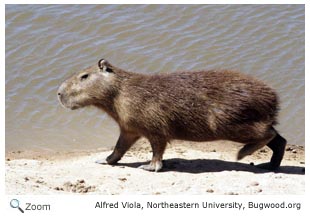Caviidae - cavies, guinea pigs, maras
 There are 18 species in this family including maras, cavies,
and guinea pigs. They are all found in South America. One species, the lesser capybara, is found in Panama in Central America. They are found in a variety of habitats including mountains, grasslands, and wetlands. Most species live in groups in burrows and are active during the day. They are herbivores. Cavies and guinea pigs look similar. They have rounded bodies, short legs, large heads, no tails, and short necks. Maras look like a little bit like hares. They have long legs, and their rear legs are longer than their front legs. There are 18 species in this family including maras, cavies,
and guinea pigs. They are all found in South America. One species, the lesser capybara, is found in Panama in Central America. They are found in a variety of habitats including mountains, grasslands, and wetlands. Most species live in groups in burrows and are active during the day. They are herbivores. Cavies and guinea pigs look similar. They have rounded bodies, short legs, large heads, no tails, and short necks. Maras look like a little bit like hares. They have long legs, and their rear legs are longer than their front legs.
The capybara is found in South America and is the largest living rodent. They stand about 1.5 feet tall and are around 4 feet long and weigh as much as 150 pounds! Capybaras have stocky bodies; reddish-brown fur; webbed toes with claws; and large heads with squared muzzles.
Capybaras are semi-aquatic and are found near lakes, ponds, swamps, rivers, and marshes. In fact, capybaras can stay under water for as long as five minutes! They are excellent swimmers, Their eyes and nose are on the top of their heads so they can keep them above the water! Capybaras are herbivores and eat grasses and aquatic plants. They are very social and live in groups of 10-40 individuals led by a male. Females have 4-7 babies.
World Status Key
 Least Concern Least Concern  Near Threatened Near Threatened  Vulnerable Vulnerable  Endangered Endangered  Critically Endangered Critically Endangered  Extinct in Wild Extinct in Wild  Extinct Extinct
Status taken from ICUN Redlist. If no status is listed, there is not enough data to establish status, or there is no status data for the species.
US Status Key
 Threatened in US Threatened in US  Threatened in NH Threatened in NH  Endangered in US Endangered in US  Endangered in NH Endangered in NH  Introduced Introduced
Status taken from US Fish and Wildlife and NH Fish and Game
New Hampshire Species |
|
North/Central American Species |
| None |
|
Lesser Capybara - Hydrochoerus isthmius
|
Additional Information
Key:  Profile Profile  Photos Photos  Video Video  Audio Audio
Brazilian Guinea Pig - Cavia aperea     
The Brazilian Guinea pig is probably the ancestor of the domestic Guinea pig.
Source: Arkive Intended Audience: General Reading Level: Middle School
Brazilian Guinea Pig - Cavia aperea    
Brazilian guinea pigs are mostly found in scrub grasslands and savannas, but they are also found in the highlands of the Andes.
Source: Animal Diversity Web Intended Audience: General Reading Level: Middle School Capybara - Hydrochoerus hydrochaeris     
The capybara is the largest rodent in the world.
Source: Arkive Intended Audience: General Reading Level: Middle School
Capybara - Hydrochoerus hydrochaeris    
Capybaras are always found near water.
Source: San Diego Zoo Intended Audience: Students Reading Level: Middle School Capybara - Hydrochoerus hydrochaeris    
Capybaras live in groups of around 10 adults.
Source: Animal Diversity Web Intended Audience: General Reading Level: Middle School
Capybara - Hydrochoerus hydrochaeris    
Capybaras can weigh more than 100 pounds.
Source: National Zoo Intended Audience: General Reading Level: Middle School
Common Yellow-toothed Cavy - Galea musteloides    
Common yellow-toothed cavies are the size of hamsters.
Source: Animal Diversity Web Intended Audience: General Reading Level: Middle School
Patagonian Mara - Dolichotis patagonum     
The Patagonian mara has rabbit-like ears and a deer-like body.
Source: Arkive Intended Audience: General Reading Level: Middle School
Patagonian Mara - Dolichotis patagonum    
The Patagonian mara is a long-legged rodent.
Source: Animal Diversity Web Intended Audience: General Reading Level: Middle School
Patagonian Mara - Dolichotis patagonum    
The Patagonian mara is found in central and southern Argentina.
Source: National Zoo Intended Audience: Students Reading Level: Middle School
Patagonian Mara - Dolichotis patagonum     
The Patagonian mara is monogamous.
Source: BBC Nature Intended Audience: General Reading Level: Middle School Rock Cavy - Kerodon rupestris    
The rock cavy is found in northeastern Brazil.
Source: Animal Diversity Web Intended Audience: General Reading Level: Middle School
Rock Cavy - Kerodon rupestris    
The rock cavy eats Leaves, grasses, and seeds.
Source: National Zoo Intended Audience: Students Reading Level: Middle School
Rock Cavy - Kerodon rupestris    
Rock cavies make a variety of vocalizations, including an alarm whistle, chirps, and squeaks.
Source: Central Park Zoo Intended Audience: Students Reading Level: Middle School Santa Catarina's Guinea Pig - Cavia intermedia   
Santa Catarina's guinea pig is only found on Moleques Island do Sul, in the state of Santa Catarina, Brazil.
Source: Arkive Intended Audience: General Reading Level: Middle School
Southern Mountain Cavy - Microcavia australis    
Southern mountain cavies are found in Argentina, southern Chile, and southern Bolivia
Source: Animal Diversity Web Intended Audience: General Reading Level: Middle School |

